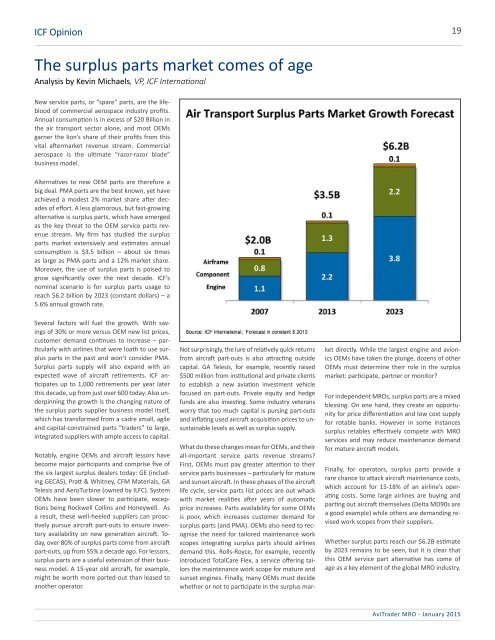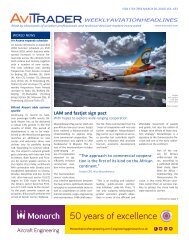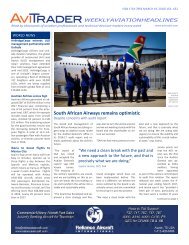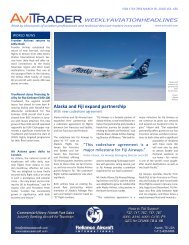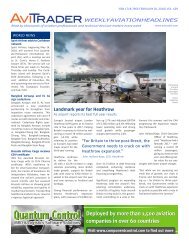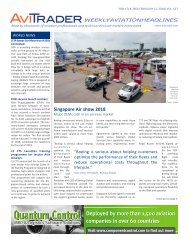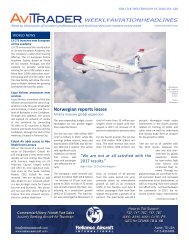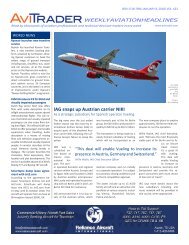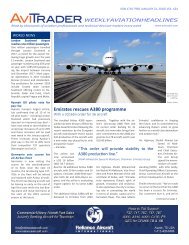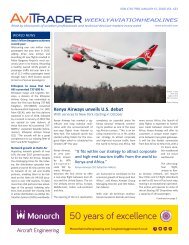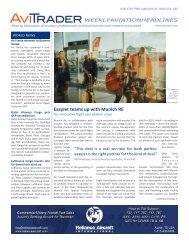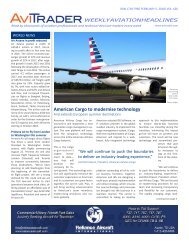AviTrader_Monthly_MRO_e-Magazine_2015-01
AviTrader_Monthly_MRO_e-Magazine_2015-01
AviTrader_Monthly_MRO_e-Magazine_2015-01
You also want an ePaper? Increase the reach of your titles
YUMPU automatically turns print PDFs into web optimized ePapers that Google loves.
ICF Opinion<br />
19<br />
The surplus parts market comes of age<br />
Analysis by Kevin Michaels, VP, ICF International<br />
New service parts, or “spare” parts, are the lifeblood<br />
of commercial aerospace industry profits.<br />
Annual consumption is in excess of $20 Billion in<br />
the air transport sector alone, and most OEMs<br />
garner the lion’s share of their profits from this<br />
vital aftermarket revenue stream. Commercial<br />
aerospace is the ultimate “razor-razor blade”<br />
business model.<br />
Alternatives to new OEM parts are therefore a<br />
big deal. PMA parts are the best known, yet have<br />
achieved a modest 2% market share after decades<br />
of effort. A less glamorous, but fast-growing<br />
alternative is surplus parts, which have emerged<br />
as the key threat to the OEM service parts revenue<br />
stream. My firm has studied the surplus<br />
parts market extensively and estimates annual<br />
consumption is $3.5 billion – about six times<br />
as large as PMA parts and a 12% market share.<br />
Moreover, the use of surplus parts is poised to<br />
grow significantly over the next decade. ICF’s<br />
nominal scenario is for surplus parts usage to<br />
reach $6.2 billion by 2023 (constant dollars) – a<br />
5.6% annual growth rate.<br />
Several factors will fuel the growth. With savings<br />
of 30% or more versus OEM new list prices,<br />
customer demand continues to increase – particularly<br />
with airlines that were loath to use surplus<br />
parts in the past and won’t consider PMA.<br />
Surplus parts supply will also expand with an<br />
expected wave of aircraft retirements. ICF anticipates<br />
up to 1,000 retirements per year later<br />
this decade, up from just over 600 today. Also underpinning<br />
the growth is the changing nature of<br />
the surplus parts supplier business model itself,<br />
which has transformed from a cadre small, agile<br />
and capital-constrained parts “traders” to large,<br />
integrated suppliers with ample access to capital.<br />
Notably, engine OEMs and aircraft lessors have<br />
become major participants and comprise five of<br />
the six largest surplus dealers today: GE (including<br />
GECAS), Pratt & Whitney, CFM Materials, GA<br />
Telesis and AeroTurbine (owned by ILFC). System<br />
OEMs have been slower to participate, exceptions<br />
being Rockwell Collins and Honeywell. As<br />
a result, these well-heeled suppliers can proactively<br />
pursue aircraft part-outs to ensure inventory<br />
availability on new generation aircraft. Today,<br />
over 80% of surplus parts come from aircraft<br />
part-outs, up from 55% a decade ago. For lessors,<br />
surplus parts are a useful extension of their business<br />
model. A 15-year old aircraft, for example,<br />
might be worth more parted-out than leased to<br />
another operator.<br />
Not surprisingly, the lure of relatively quick returns<br />
from aircraft part-outs is also attracting outside<br />
capital. GA Telesis, for example, recently raised<br />
$500 million from institutional and private clients<br />
to establish a new aviation investment vehicle<br />
focused on part-outs. Private equity and hedge<br />
funds are also investing. Some industry veterans<br />
worry that too much capital is pursing part-outs<br />
and inflating used aircraft acquisition prices to unsustainable<br />
levels as well as surplus supply.<br />
What do these changes mean for OEMs, and their<br />
all-important service parts revenue streams?<br />
First, OEMs must pay greater attention to their<br />
service parts businesses – particularly for mature<br />
and sunset aircraft. In these phases of the aircraft<br />
life cycle, service parts list prices are out whack<br />
with market realities after years of automatic<br />
price increases. Parts availability for some OEMs<br />
is poor, which increases customer demand for<br />
surplus parts (and PMA). OEMs also need to recognise<br />
the need for tailored maintenance work<br />
scopes integrating surplus parts should airlines<br />
demand this. Rolls-Royce, for example, recently<br />
introduced TotalCare Flex, a service offering tailors<br />
the maintenance work scope for mature and<br />
sunset engines. Finally, many OEMs must decide<br />
whether or not to participate in the surplus market<br />
directly. While the largest engine and avionics<br />
OEMs have taken the plunge, dozens of other<br />
OEMs must determine their role in the surplus<br />
market: participate, partner or monitor?<br />
For independent <strong>MRO</strong>s, surplus parts are a mixed<br />
blessing. On one hand, they create an opportunity<br />
for price differentiation and low cost supply<br />
for rotable banks. However in some instances<br />
surplus retables effectively compete with <strong>MRO</strong><br />
services and may reduce maintenance demand<br />
for mature aircraft models.<br />
Finally, for operators, surplus parts provide a<br />
rare chance to attack aircraft maintenance costs,<br />
which account for 15-18% of an airline’s operating<br />
costs. Some large airlines are buying and<br />
parting out aircraft themselves (Delta MD90s are<br />
a good example) while others are demanding revised<br />
work scopes from their suppliers.<br />
Whether surplus parts reach our $6.2B estimate<br />
by 2023 remains to be seen, but it is clear that<br />
this OEM service part alternative has come of<br />
age as a key element of the global <strong>MRO</strong> industry.<br />
<strong>AviTrader</strong> <strong>MRO</strong> - January <strong>2<strong>01</strong>5</strong>


